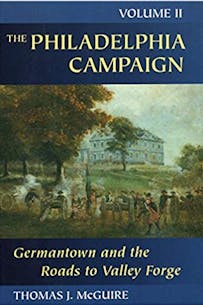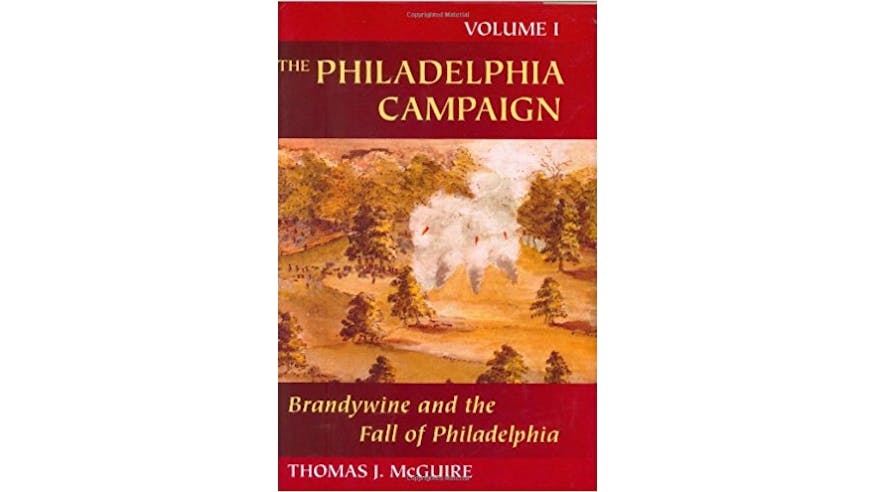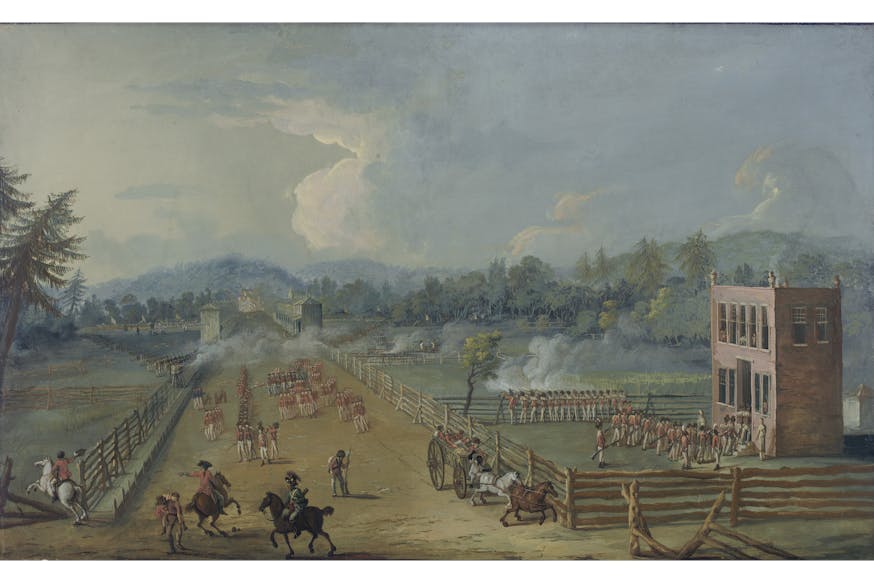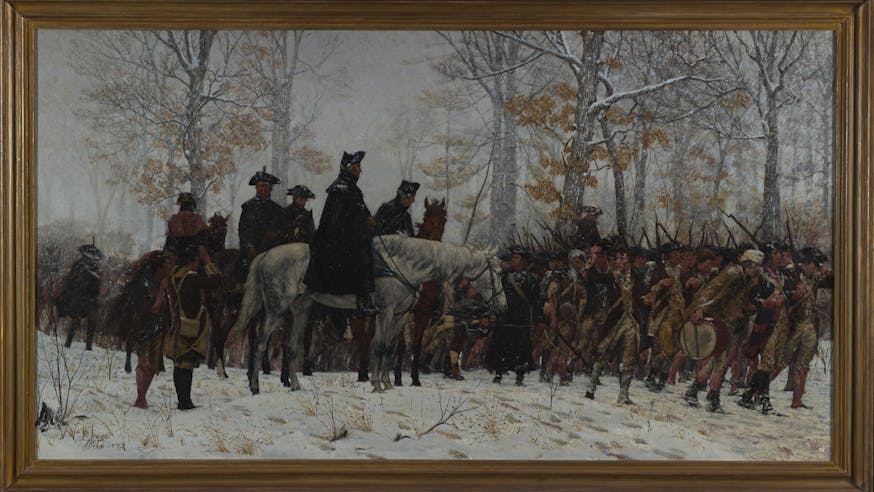Read the Revolution
The Philadelphia Campaign, Vol. II
September 26,2018
Purchase the book from the Museum Shop.
On the morning of October 4, 1777, General George Washington went on the offensive. In the weeks prior, Washington’s troops suffered a defeat at the Battle of Brandywine, survived a bloody night attack at Paoli, and witnessed the capture of Philadelphia, the American capital. By attacking British General William Howe’s army at Germantown, Washington hoped to change the course of the fight to control Philadelphia.
Following up on his first volume that focuses on the Battle of Brandywine, historian Thomas J. McGuire narrates the second half of the struggle for the American capital in The Philadelphia Campaign, Volume II: Germantown and the Roads to Valley Forge. McGuire personalizes the story of the campaign by quoting extensively from journals and memoirs written by American (Loyalist and Revolutionary), British, and Hessian participants. He effectively captures the mood of individual soldiers and civilians caught up in the conflict.
General Washington did not succeed at the Battle of Germantown and the British held Philadelphia for a total of nine months. However, McGuire’s book does not end at Germantown. He instead shares fascinating details about the other battles surrounding Philadelphia like the Battle of Red Bank (Fort Mercer) and the Siege of Fort Mifflin and finishes with the beginning of the Continental Army’s encampment at Valley Forge. These lesser-known battles disrupted British control over the region and made the occupation of Philadelphia a difficult task.
The following excerpt summarizes the immediate aftermath of the Battle of Germantown. Even though the Continental Army retreated, Brigadier General Anthony Wayne thought the battle provided the Army with a morale boost.
Excerpt
The American troops were scattered far and wide. Lt. Gilbert Purdy of the British Corps of Guides and Pioneers commented, "the Rebels Retreted As Usual & We pursued them About 13 miles from Garming town & killed & took A grat number of them it being the Boldest Atact that ever they had made." Lt. Frederick Wetherall of the 17th Light Company officer wrote, "The greatest part of their Rear hid themselves in houses, others throwing-away their Arms took [off] across the Country."
Liquor had played a role in the battle on the American side, both fortifying the men and contributing to the confusion. "The power of strong liquors had been employed," Andre wrote in his journal, "several, not only of their Soldiers but Officers, were intoxicated when they fell into our hands." Gen. Adam Stephen was said to have been drunk yet again, "more especially in the action of the 4th instant at and about Germantown. "He was court-martialed afterward, charged with "Acting unlike an officer" and "Drunkenness, or drinking so much, as to act frequently in a manner, unworthy the character of an officer." Stephen was found guilty, and cashiered from the army. "They got Rum three times: before they set out-halfway-and at Chestnut Hill, when they drew near," General Grant wrote. "If I may judge from the situation I found a Colonel & two Majors in, they were certainly all drunk."
Capt. Charles Willson Peale, who was coming down the Old York Road from Bucks County, paused to feed his horse at the Crooked Billet Tavern near Horsham Meeting, about ten miles above Germantown. There, "I see some of our men coming up the Road from whom I learnt that our men was Retreating." Peale then headed west, pausing at the Spring House Tavern in Gwynedd Township for more information. He then continued over toward the Skippack Road several miles further on, passing the Foulke farm in Penllyn where Sally Wister and her family were lodged. (Sally, unfortunately, wrote nothing about the battle other than "Heaven defend us from so dreadful a sight. The battle of Germantown, and the horrors of that day, are recent in my mind" a few weeks later.)
Arriving at the Skippack Road, "I was informed the Enemy was pursuing" Peale wrote. He also found out that his brother James "was on the Reading Road" [Germantown Pike] still further west. "I Rode on the Skipack Road Enquiring for my Brothers till I Reached the Encampment our men had left the Eveng. Before" at Methacton Hill in Worcester Township. He then proceeded nine miles further, all the way up to "our old Encampment at Penn Packer mills (or Penna Pecker mills)," twentyfour miles from Germantown, and rested until "the Coming up of a great number of our Troops." He did not find his brothers until the next day, posted over on the Reading Road below Trappe.
After pursuing the Continental Army all the way to Whitemarsh, the Crown Forces headed back to the Germantown camp. The British Grenadiers "return'd in the Evening to Philada. after a march of 4 or 5 & 30 miles" Captain-Lieutenant Peebles of the Royal Highland Grenadier Company wrote, somewhat exhausted from the sojourn. As for Washington's troops, "We then marched up the Skippack road to Pennybecker's Mill, where we betook ourselves to rest at 9 P.M.," Lieutenant McMichael wrote in his diary.
"Thus happened the memorable Battle of Germantown, in which great numbers were killed on both sides, and which lasted from 5 to 10 o'clock," McMichael continued, with a poignant analysis of the day's experience. "That of Brandywine, was not in any measure such a general attack, neither was the loss at that place any way equivalent." Of the marching the night before, the battle itself, and the retreat, McMichael bluntly stated, 'I had previously undergone many fatigues, but never any that so much overdone me as this. Had it not been for the fear of being taken prisoner, I should have remained on the road all night. I had marched in twenty-four hours 45 miles, and in that time fought four hours, during which we advanced so furiously thro' buckwheat fields, that it was almost an unspeakable fatigue."
Washington's attack at Germantown had been a surprise in many ways, and showed the possibilities of military success. Though it was a defeat for the Americans, it raised morale significantly in the Continental Army. The British had won the battle more by default than design, thanks to the heroic actions of Musgrave and a few others.
The bravery of the 40th Regiment at Cliveden made a lasting impression in the British Army. Sir George Osborn, who wrote only two sentences about the battle at the time, became colonel of the 40th Regiment in 1786 and remained in command for many years. He was so impressed by the unit's valor that, at his own expense, he had a battle medal struck in bronze for the men and in silver for the officers. A watercolor image of the battle at Cliveden, inaccurately titled "A View of Cheeves House, near Philadelphia, under seige by Washington's army, 3rd October 1777, and defended by the 40th Regiment under the command of Lt. General Musgrove," is one of several contemporary images of the battle and served as the basis for the obverse of the medal. The decoration first appeared in public at a military review in Liverpool, England, on May 25, 1789. "The Officers of this Regiment Wear also a silver Medal round their necks presented to them by the present Colonel," the army record notes, "in memory of the very gallant and noble stand the Regiment made at German Town" Regulations being regulations, the officer commanding the review was obliged to state, "which however proper, and tending to keep up the memory of the extraordinary good behaviour of the Regiment on that Duty, I find wants the sanction of His Majesty's Approbation to be Entered in the Regimental Orderly Books." The Germantown medal is recognized as one of the earliest examples of a British Army decoration for valor, predating the Victoria Cross by more than half a century.
"But what are the Advantages gained by our victories?" a frustrated New York Loyalist wrote to a friend in England. "None. The Rebellion is more established, more general than ever:' Utterly discouraged, he cried, "The Rebels have been made Soldiers by our lessons: they even attacked the King's troops in battle-array, as was the case at German-Town." The battle was a surprise in more than one sense.
For once, Anthony Wayne would have wholeheartedly agreed with the Loyalist. "Upon the Whole," he told Polly, "it was a Glorious day."
Sign Up
Get biweekly Read the Revolution featured excerpts right to your inbox.
Tags
Learn More

The Philadelphia Campaign, Vol. I

Battle of Germantown
